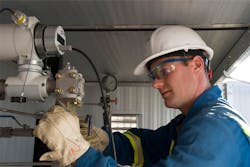The selection of an insertion turbine flowmeter to measure the combustion air flow in an incinerator was discussed previously. Other flow technologies may have been preferable from a maintenance perspective because we did not have any similar turbine flowmeters in the plant. However, the insertion turbine flowmeter was the only flowmeter found that would meet the requirements of the application. Therefore, once installed, we had to maintain this instrument and a similar flowmeter used to measure the natural gas flow to the incinerator.
Theoretically, calibrating the flowmeter involves verifying the performance of the flow element (turbine) and transmitter. Calibrating the transmitter is relatively straightforward. However, verifying the performance of the turbine is not easy because the flowmeter measurement should be compared to the passage of a known amount of fluid. We did not have a gas calibration facility to perform these calibrations, nor were we willing to incur the cost associated with sending them out for calibration.
Recognizing that turbines tend to slow down before they stop working, a surrogate method to check the operation of the turbine was to blow on the turbine and observe how quickly it stopped spinning. A new turbine will spin for quite some time, while a worn turbine will stop relatively quickly.
By experience, we found that the turbine in the combustion air service would slow down somewhat after six months of operation and require replacement after one year. Interestingly, the turbine in natural gas service spun almost like new after seven years of operation!
In these applications, the calibration interval was not so much dependent on the measurement instrument itself but rather on the service in which it was installed.
David W. Spitzer is a regular contributor to Flow Control magazine and a principal in Spitzer and Boyes LLC, which offers engineering, seminars, strategic, marketing consulting, distribution consulting and expert witness services for manufacturing and automation companies. Spitzer and Boyes is also the publisher of the Industrial Automation INSIDER. He has more than 40 years of experience and has written more than 10 books and 350 articles about flow measurement, instrumentation and process control. Spitzer may be reached at 845-623-1830 or via spitzerandboyes.com. Click on the “Products” tab to find his Consumer Guides to various flow and level measurement technologies.



